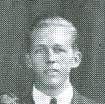Biography
Kenneth Norman Okeson was born in Wakefield, Nebraska on February 2, 1917 to Andrew and Marie Okeson. Wakefield is a bit west and south of Sioux City, just over the Nebraska border.
Kenneth was the last of four children in the Okeson family, and we wonder if he was a bit of a surprise to his parents, coming along when his mother was 35 and his father was 45. He had two brothers, Anton and Nels, and a sister, Vera.
He grew up in the Wakefield area, attended grade school there and was confirmed in the Salem Lutheran Church.
In 1929 when he was 12 years old, Kenneth’s mother died and his father - who was 57 years old - made the decision to send Kenneth to Omaha to live with his older brother.
Kenneth completed his education there, graduating from Omaha Technical High School in 1935.
That fall, he enrolled at Iowa State, declaring a major in Civil Engineering. He continued taking classes through the winter quarter of 1939.
He was an active member of Theta Xi fraternity and college yearbooks from that era show a neatly dressed, blonde-haired young man among his fraternity brothers in the group picture. We can only assume that he enjoyed the camaraderie and activities that came with living in a college fraternity house, but true love struck and in November 1939, he married Miss Lorene Lee in St. Louis, the niece of a family friend from back home in Wakefield.
Kenneth took a job in Harrisburg, Illinois as a civil engineer for the Sahara Coal Company and lived there with Lorene until he entered the service in June 1942, seven months after the attack on Pearl Harbor.
He served with the Army Air Corps, and in October 1943 received a commission of second lieutenant in Miami, Florida. After a few days’ leave with his father at home in Wakefield, he departed for England on December 23, 1943, and was based there for five months.
He was a navigator on a C-47 transport plane, serving in the 81st Squadron, 436th Troop Carrier Group.
The C-47 Skytrain was the Army Air Corps’ standard transport aircraft. It could carry up to 6,000 pounds of cargo – such as a fully assembled jeep, or a 37 mm cannon or 28 soldiers in full combat gear. During World War 2, C-47s operated from every continent in the world and participated in every major battle. They came to be known universally as the "Gooney Bird."
For a period of time Kenneth was transferred from England to Italy, but returned to England as one of thousands of service personnel preparing for the invasion of Normandy. He took part in that monumental operation as well as the invasion of northern France.
He was promoted to the rank of first lieutenant and awarded the Distinguished Flying Cross with an oak leaf cluster. The Distinguished Flying Cross is a medal awarded to a member of the armed forces who is distinguished in support of operations by "heroism or extraordinary achievement while participating in an aerial flight” – displaying actions that went above and beyond the call of duty.
An oak leaf cluster is placed on a military decoration to indicate that the recipient has received more than one of that type of medal.
On September 17, 1944, the Allies launched Operation Market Garden. It was an attempt by combined Allied airborne and ground assault troops to capture bridges over Dutch waterways that would open a northern route for the rapid Allied advance into Germany. It was the largest Allied airborne operation of the war.
On the third day of Operation Market Garden, September 19, 1944, the British were advancing from Belgium to Holland. Paratroopers were dropped at Arnheim (ARN- hime) and unexpectedly encountered heavy German resistance.
Kenneth was flying a mission over Holland that day – probably dropping troops - and his plane was shot down. He was reported missing and eventually declared killed in action.
After his heroic efforts in support of the Allied advance, Kenneth would have been pleased to know his final effort was one of the many key actions that lead to the end of the war eight months later.
Kenneth is buried in the Netherlands American Cemetery, Margraten Netherlands.
